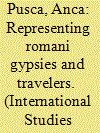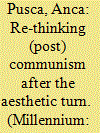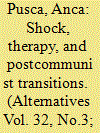|
|
|
Sort Order |
|
|
|
Items / Page
|
|
|
|
|
|
|
| Srl | Item |
| 1 |
ID:
140879


|
|
|
|
|
| Summary/Abstract |
Images of Romani Gypsies and Travelers abound in popular culture and the press, feeding into a series of stereotypes that appear to have survived largely unchanged for well over 200 years. With Romani and Traveler communities increasingly at the center of important debates on the treatment of migrants and ethnic minorities in Europe, these representations offer important insights into when and why Roma communities are sometimes conveniently visible or invisible, and how national and EU actors use their (in)visibility to make particular claims about solutions to discrimination. This article argues that although Roma and Traveler representations continue to follow traditional stereotypes, there is a noticeable change in their nature and the role that they play in both Roma and non-Roma communities. By juxtaposing iconic photographic representations of Gypsies by Josef Koudelka in 1960s Czechoslovakia and the rise of new reality TV series such as My Big Fat Gypsy Wedding and American Gypsies, this article aims to show the nature of change in Romani and Traveler representations and how they perform their collective identities.
|
|
|
|
|
|
|
|
|
|
|
|
|
|
|
|
| 2 |
ID:
109170


|
|
|
|
|
| Publication |
2011.
|
| Summary/Abstract |
Almost 20 years after the 1989 Romanian revolution, the subject is experiencing a powerful comeback in a number of cinematic reflections that are at the forefront of the so-called Romanian New Wave, including Corneliu Porumboiu's 12:08 East of Bucharest, Radu Muntean's The paper will be blue and Catalin Mitulescu's How I spent the end of the world. This article seeks to establish some of the contributions that the New Wave is making to the reconstruction of the 1989 revolutionary moment, but also, and more importantly, to the renegotiation of Romania's present role in the local and global imaginary. The article offers a particular reading of these films as inspired by Walter Benjamin's writings on history and film, a reading that seeks to understand the careful temporal and spatial renegotiation of the revolutionary moment of December 1989, the key role that the technology of film has played throughout the course of the Romanian revolution and its aftermath, as well as the critical importance that the revolutionary moment continues to have for the way in which Romania imagines itself and is seen from abroad.
|
|
|
|
|
|
|
|
|
|
|
|
|
|
|
|
| 3 |
ID:
152111


|
|
|
|
|
| Summary/Abstract |
The relationship between art and politics was in many ways uniquely important in communist spaces, where the totalising experience of the communist state and ideology needed to be built quickly and emerge in a way that would completely control the visibility of ‘change’. Not unlike the post-communist transition experience, the communist experience was also dominated by an ethos of aggressive social change and progress. Measuring both change and progress was instrumental to the communist state, and art – especially propaganda art – played an essential role in instigating, legitimising and rendering change visible. From posters, to public statues, to rising industrial platforms and communist blocs, to new avenues and massive public infrastructure projects, the ‘artist’ – whether an architect, painter, plastic artist, performer or poet – was an essential ‘tool’ in the ideological arsenal of the communist state. It is thus not surprising that any serious study of politics in the post-communist context needs to take the question of ‘art’ and ‘aesthetics’ seriously.
|
|
|
|
|
|
|
|
|
|
|
|
|
|
|
|
| 4 |
ID:
080008


|
|
|
|
|
| Publication |
2007.
|
| Summary/Abstract |
This article explores how the concept of shock has been used in connection to processes of social change and transition, and argues that a wider exploration of the concept in fields other than political science and international relations can provide us with important insights into the individual and collective impacts of transitions. Although criticizing the idea of shock as therapy, the article presents a number of alternative uses of shock that can be particularly insightful for understanding often contradictory behaviors that characterize periods of transition, as well as a series of dangerous consequences of attempts to deal with shock through various techniques of distancing, distraction, and normalization
|
|
|
|
|
|
|
|
|
|
|
|
|
|
|
|
| 5 |
ID:
082258


|
|
|
|
|
| Publication |
2008.
|
| Summary/Abstract |
Starting with an analysis of the recent launch of EUTube, this article poses a
number of different questions about the EU's visibility, particularly from a Central and East
European perspective. Arguing against the more commonly held belief that the EU's visibility
is on the decline, the article showcases a number of alternative examples of visibility
whereby other actors, coming from the publicity world, critically engage with problems
surrounding the EU such as discrimination, the work?visa regime, the EU Constitution and
the CAP reforms. Focusing on the Polish Plumber campaign in France and Poland as well as
the Bucegi and Ursus beer campaigns in post?enlargement Romania, the article argues that
such campaigns could and should play an important role in expanding the visual horizon of
the EU and opening the door to other 'legitimate' authors of 'text' and 'images' pertaining to
the EU.
|
|
|
|
|
|
|
|
|
|
|
|
|
|
|
|
|
|
|
|
|